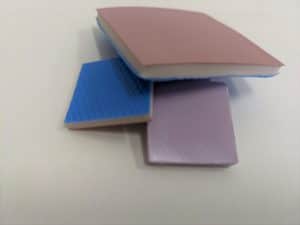
gap filler pad, thick
Oftentimes, customers come to us looking for thermal solutions. The problem with filling thick gaps when trying to solve a thermal solution is many typical thermal interface solutions won’t be a good fit to solve the problem.
Reasons other Thermal Management Products Don’t Work
Phase Change Materials-too thin
Thermal Tapes– too thin
Greases- extrudes due to not being cured.
Pastes- extrudes due to not being cured.
With everything below, it is good to keep in mind that thermal performance craters with the thicker the thermal solution.
Lastly, when filling a gap it is good to keep in mind that the gap filling solution should be thicker than the gap itself. For example, a .210’’ gap may be accommodated by a .250’’ Gap Pad.
Different Solutions to Test
Solution 1:
Find a Gap Pad That is Thick Enough:
One concern with gap filling pads is the fact that many gap filler pads do not come in thicknesses above .125’’. This can be a problem. However, companies such as Henkels’ Bergquist have many selections. There are a few Gap Filling Pads that come in thicknesses above .125’’:
-Gap Pad 1500
-Gap Pad VOUS
-Gap Pad VOS
-Gap Pad VO
-Gap Pad 1500S30
-Gap Pad 2500S20
All of these thermal interface pads are available in 8’’ x 16’’ sheet solutions.
Solution 2:
Ply em’ Up:
We have seen customers ply up two different gap pad thicknesses utilizing the natural tack in order to achieve a thicker height.
For example, an engineer likes the qualities of a certain Gap Filling Pad material. The intended gap to be filled is .250’’ wide. However, this gap pad does not come in the thickness that would be required to fill the gap. This gap filling pad only comes up to .125’’ in thickness. By plying up two .125’’ pads, you can achieve .250’’. Generally, this is going to result in reduced thermal performance. In addition, we would encourage customers to test different plies of materials that feature different levels of natural tack. However, while it is not an ideal solution and there is increased risk of the two Gap Pads separating rather than one whole piece, we have seen customers do it.
More Information
NEDC die-cuts, and waterjet-cuts different custom shapes of thermal interface pads. For more information on filling thick gaps for thermal materials, please contact sales@nedc.com.